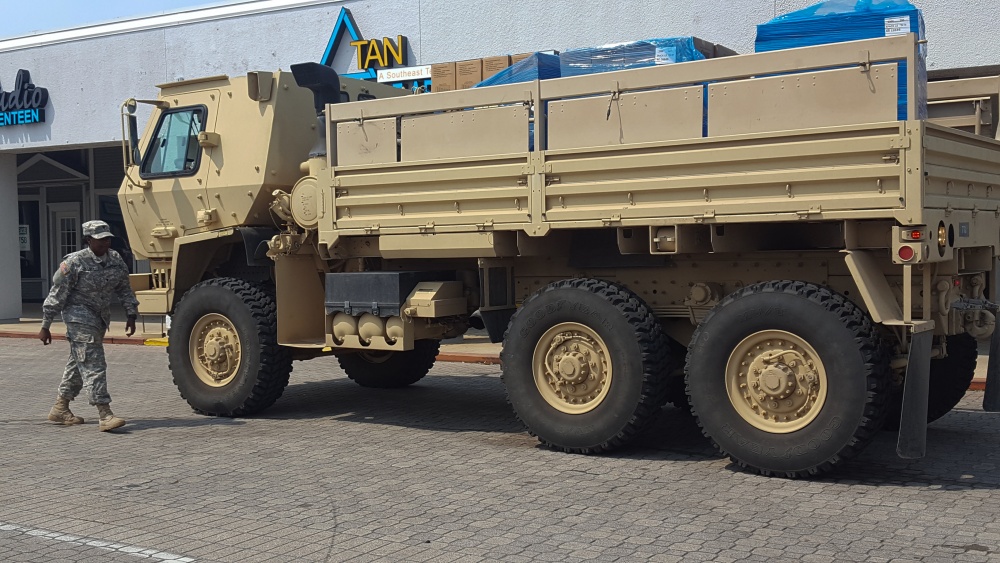 Photo By Spc. Nathaniel Free | Spc. Markeisha Dudley, a member of Company A, 949th Brigade Support Battalion from Fort Worth, Texas, arrives at a point of distribution station in the City of Orange on 7 September, 2017. Dudley has been collecting donations, transporting supplies on pallets, and distributing everything from trash bags to baby formula since she was activated with her unit in the wake of Hurricane Harvey.
Photo By Spc. Nathaniel Free | Spc. Markeisha Dudley, a member of Company A, 949th Brigade Support Battalion from Fort Worth, Texas, arrives at a point of distribution station in the City of Orange on 7 September, 2017. Dudley has been collecting donations, transporting supplies on pallets, and distributing everything from trash bags to baby formula since she was activated with her unit in the wake of Hurricane Harvey.
ORANGE, TX, UNITED STATES
09.07.2017
Story by Spc. Nathaniel Free
128th Mobile Public Affairs Detachment
BEAUMONT, Texas — In the early morning hours of August 25, 2017, Hurricane Harvey slammed into eastern Texas as a Category 4 storm, followed by days of record-breaking rainfall.
“I was evacuated shortly after the hurricane hit,” said Staff Sgt. Ernesto Luevano, a local of Houston, who serves the Texas National Guard’s 551st Multi-Role Bridge Company, located in El Campo, Texas.
By the time Luevano had driven his wife and child to safety, he had received mobilization orders from his unit. As a citizen-Soldier, he dutifully said goodbye to his family, turned his truck around, and returned through flooded neighborhoods to retrieve his military gear from his home.
“I picked up my rucksack and it was full of water,” Luevano said.
Luevano is just one of thousands of citizen-Soldiers in the Texas National Guard who’s life has been interrupted by Hurricane Harvey. The 551st was one of the first units to respond to the call, and deployed in areas still flooded with over 40 inches of rain.
“We’ve been going out in trucks to neighborhoods where there’s water. We go as far as we can, then deploy the Zodiacs,” said Luevano.
A Combat Rubber Reconnaissance Craft, commonly referred to as a Zodiac, is a versatile inflatable boat that can be carried in the back of a flatbed truck. The high-profile trucks can drive in floodwaters as deep as five feet before deploying the boats, Luevano said.
“We go house to house knocking, screaming, doing whatever we can to find people,” said Luevano. “We started out in Houston and we’ve been working our way east. The last place we went to was Orange.”
There are approximately 30 points of distribution stations, called PODs, set up in and around the city of Orange, to provide vital commodities like food and water. Mobile PODs also require Soldiers to brave floodwaters to reach people unable to obtain supplies because of road conditions, or because they’ve lost their only means of transportation.
“I saw it on the news, getting worse and worse, so I told my fiancé it looks like we might be getting pushed out,” Spc. Markeisha Dudley said, a member of Company A, 949th Brigade Support Battalion, located in Fort Worth, Texas.
The 949th BSB was activated August 28, and has since been managing various PODs across the hurricane-affected area, not only saving lives, but also restoring livelihoods.
Dudley said her fiancé, Brandon, has been extremely supportive.
“We were planning to get married on September 3rd. We’ve been planning a big wedding for quite some time, and invited a lot of people,” she said. “We had to call everyone, and postpone it. He knows that the people out here need me.”
Dudley has been collecting donations, transporting supplies and distributing everything from trash bags to baby formula. With less than six months before the end of her military contract, it’s given her time to reflect.
“This is what I signed up for. This is the action that I wanted. It’s made me think about re-classing instead of getting out. When I was a young child, I saw the Army coming in and asked, ‘who’s that?’ It was the National Guard. That’s what I wanted to do,” Dudley said.
Luevano and Dudley are just two of more than 16,000 military personnel currently on the ground, volunteering to live a life interrupted by duty.